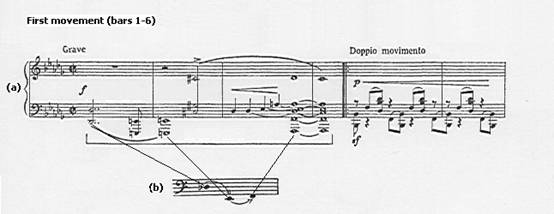In Frederic Chopin:
Profiles of the Man and the Musician, Alan Walker devotes a number of pages
to Chopin's second piano sonata in his chapter on "Chopin and Musical
Structure." He, like Réti, emphasises the importance of the introductory bars,
stating that they determine "...the thematic destiny of the entire work."
Walker interprets the falling diminished seventh and rising second in the bass
clef of the Grave as "...the cells out
of which Chopin's intuitive genius builds one of his most 'spontaneous' works."
This motif is shown in Example 23(b):
Example 23:
Derivation of motif (b) from bars 1-4 of the first movement (a)

Building on Réti's analysis of the first subject of the
Allegro, Walker
states that an octave transposition of the first three notes of this subject
shows that it clearly derives from the first three notes of the work, as shown
in Example 24. Like Leichtentritt and Réti, he points out the derivation of the
second subject from the first, where the first few notes of the second subject
form an augmented version of motif X. This is